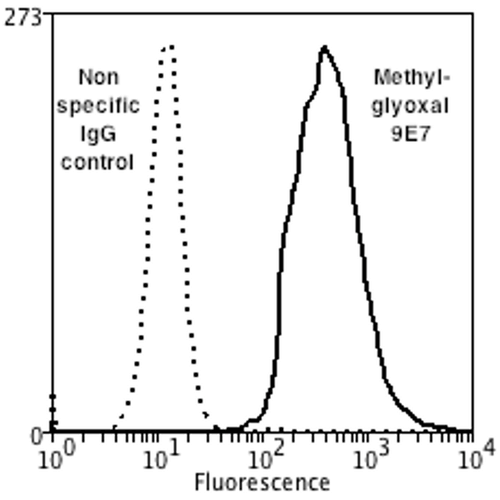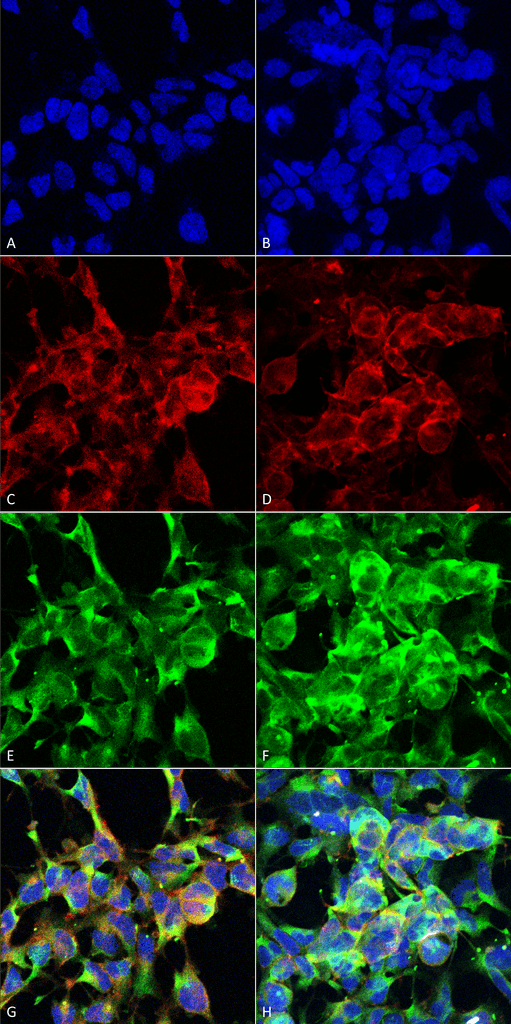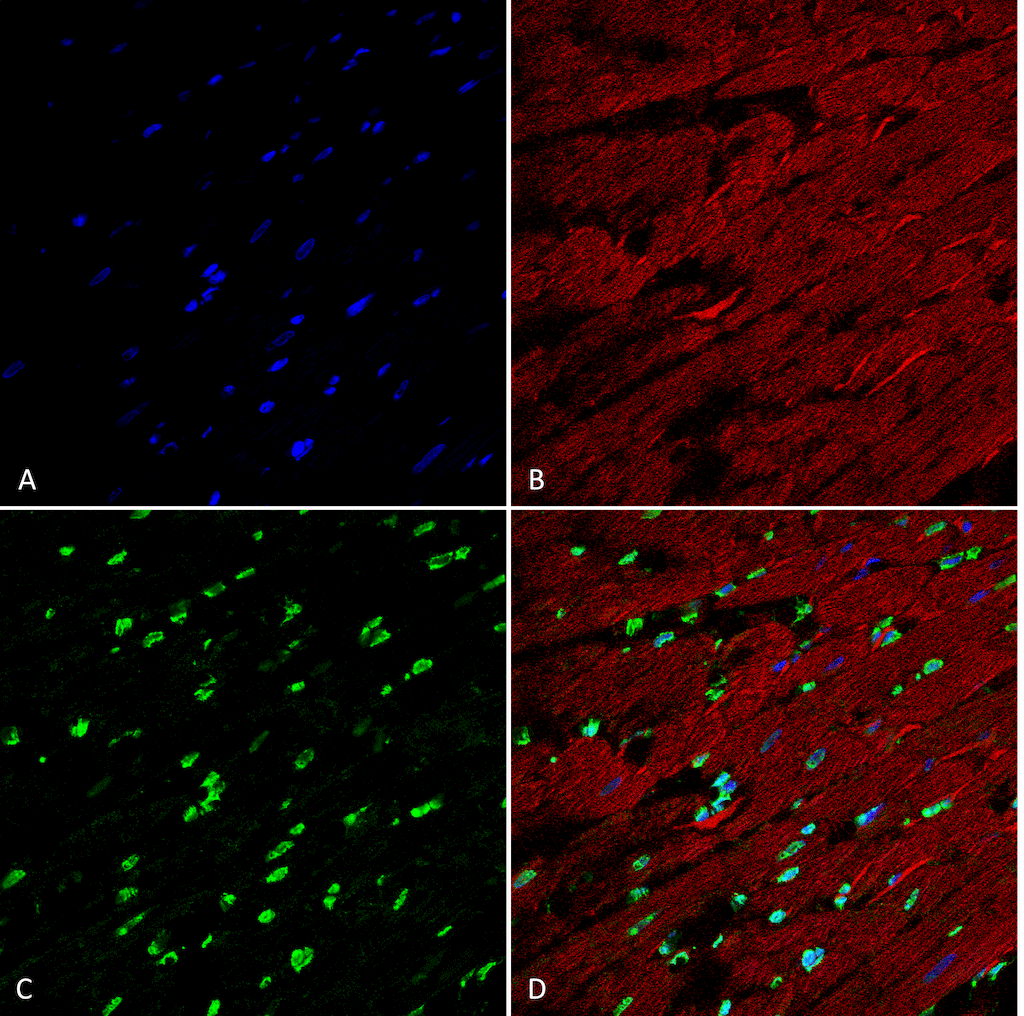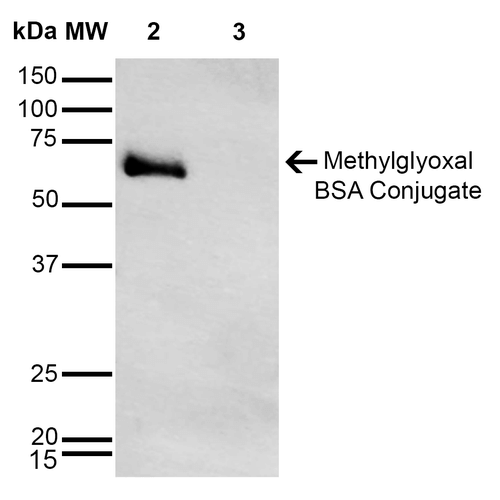Anti-Methylglyoxal Mouse Monoclonal Antibody (56617)
Anti-Methylglyoxal Mouse Monoclonal Antibody (56617)
Product No.: 56617
- -
- -
Clone 9E7 Target Methylglyoxal Formats AvailableView All Product Type Monoclonal Alternate Names Methylglyoxal, 2-Oxopropanal, 2 oxo propanal, MG, Pyruvaldehyde, Methylglyoxal (MG), MG-modified protein Isotype Mouse IgG2a Applications ELISA , FACS , ICC , IF , WB , FCM |
Data
 Flow Cytometry analysis using Mouse Anti-Methylglyoxal Monoclonal Antibody, Clone 9E7 . Tissue: Neuroblastoma cells (SH-SY5Y). Species: Human. Fixation: 90% Methanol. Primary Antibody: Mouse Anti-Methylglyoxal Monoclonal Antibody at 1:50 for 30 min on ice. Secondary Antibody: Goat Anti-Mouse: PE at 1:100 for 20 min at RT. Isotype Control: Non Specific IgG. Cells were subject to oxidative stress by treating with 250 µM H2O2 for 24 hours.
Flow Cytometry analysis using Mouse Anti-Methylglyoxal Monoclonal Antibody, Clone 9E7 . Tissue: Neuroblastoma cells (SH-SY5Y). Species: Human. Fixation: 90% Methanol. Primary Antibody: Mouse Anti-Methylglyoxal Monoclonal Antibody at 1:50 for 30 min on ice. Secondary Antibody: Goat Anti-Mouse: PE at 1:100 for 20 min at RT. Isotype Control: Non Specific IgG. Cells were subject to oxidative stress by treating with 250 µM H2O2 for 24 hours. Immunocytochemistry/Immunofluorescence analysis using Mouse Anti-Methylglyoxal Monoclonal Antibody, Clone 9E7 . Tissue: Embryonic kidney epithelial cell line (HEK293). Species: Human. Fixation: 5% Formaldehyde for 5 min. Primary Antibody: Mouse Anti-Methylglyoxal Monoclonal Antibody at 1:50 for 30-60 min at RT. Secondary Antibody: Goat Anti-Mouse Alexa Fluor 488 at 1:1500 for 30-60 min at RT. Counterstain: Phalloidin Alexa Fluor 633 F-Actin stain; DAPI (blue) nuclear stain at 1:250, 1:50000 for 30-60 min at RT. Magnification: 20X (2X Zoom). (A,C,E,G) – Untreated. (B,D,F,H) – Cells cultured overnight with 50 µM H2O2. (A,B) DAPI (blue) nuclear stain. (C,D) Phalloidin Alexa Fluor 633 F-Actin stain. (E,F) Methylglyoxal Antibody. (G,H) Composite. Courtesy of: Dr. Robert Burke, University of Victoria.
Immunocytochemistry/Immunofluorescence analysis using Mouse Anti-Methylglyoxal Monoclonal Antibody, Clone 9E7 . Tissue: Embryonic kidney epithelial cell line (HEK293). Species: Human. Fixation: 5% Formaldehyde for 5 min. Primary Antibody: Mouse Anti-Methylglyoxal Monoclonal Antibody at 1:50 for 30-60 min at RT. Secondary Antibody: Goat Anti-Mouse Alexa Fluor 488 at 1:1500 for 30-60 min at RT. Counterstain: Phalloidin Alexa Fluor 633 F-Actin stain; DAPI (blue) nuclear stain at 1:250, 1:50000 for 30-60 min at RT. Magnification: 20X (2X Zoom). (A,C,E,G) – Untreated. (B,D,F,H) – Cells cultured overnight with 50 µM H2O2. (A,B) DAPI (blue) nuclear stain. (C,D) Phalloidin Alexa Fluor 633 F-Actin stain. (E,F) Methylglyoxal Antibody. (G,H) Composite. Courtesy of: Dr. Robert Burke, University of Victoria. Immunohistochemistry analysis using Mouse Anti-Methylglyoxal Monoclonal Antibody, Clone 9E7 . Tissue: Heart. Species: Rat. Fixation: Formalin fixed, paraffin embedded. Primary Antibody: Mouse Anti-Methylglyoxal Monoclonal Antibody at 1:25 for 3 hour at RT. Secondary Antibody: Goat Anti-Mouse IgG: Alexa Fluor 488. Counterstain: DAPI (blue) nuclear stain. Magnification: 63X. (A) DAPI (blue) nuclear stain. (B) Actin (C) Methylgyloxal Antibody (D) Composite.
Immunohistochemistry analysis using Mouse Anti-Methylglyoxal Monoclonal Antibody, Clone 9E7 . Tissue: Heart. Species: Rat. Fixation: Formalin fixed, paraffin embedded. Primary Antibody: Mouse Anti-Methylglyoxal Monoclonal Antibody at 1:25 for 3 hour at RT. Secondary Antibody: Goat Anti-Mouse IgG: Alexa Fluor 488. Counterstain: DAPI (blue) nuclear stain. Magnification: 63X. (A) DAPI (blue) nuclear stain. (B) Actin (C) Methylgyloxal Antibody (D) Composite. Western Blot analysis of Methylglyoxal-BSA Conjugate showing detection of 67 kDa Methylglyoxal protein using Mouse Anti-Methylglyoxal Monoclonal Antibody, Clone 9E7 . Lane 1: Molecular Weight Ladder (MW). Lane 2: Methylglyoxal-BSA. Lane 3: BSA. Load: 0.5 µg. Block: 5% Skim Milk in TBST. Primary Antibody: Mouse Anti-Methylglyoxal Monoclonal Antibody at 1:1000 for 2 hours at RT. Secondary Antibody: Goat Anti-Mouse IgG: HRP at 1:1000 for 60 min at RT. Color Development: ECL solution for 5 min in RT. Predicted/Observed Size: 67 kDa.
Western Blot analysis of Methylglyoxal-BSA Conjugate showing detection of 67 kDa Methylglyoxal protein using Mouse Anti-Methylglyoxal Monoclonal Antibody, Clone 9E7 . Lane 1: Molecular Weight Ladder (MW). Lane 2: Methylglyoxal-BSA. Lane 3: BSA. Load: 0.5 µg. Block: 5% Skim Milk in TBST. Primary Antibody: Mouse Anti-Methylglyoxal Monoclonal Antibody at 1:1000 for 2 hours at RT. Secondary Antibody: Goat Anti-Mouse IgG: HRP at 1:1000 for 60 min at RT. Color Development: ECL solution for 5 min in RT. Predicted/Observed Size: 67 kDa. - -
- -
Antibody DetailsProduct DetailsReactivity Species Species Independent Host Species Mouse Immunogen Synthetic Methylglyoxal modified Keyhole Limpet Hemocyanin (KLH). Product Concentration 1 mg/mL Formulation PBS pH 7.4, 50% glycerol, 0.09% Sodium azide State of Matter Liquid Product Preparation Protein G Purified Storage and Handling This antibody is stable for at least one (1) year at -20°C. Avoid multiple freeze-thaw cycles. Regulatory Status Research Use Only Country of Origin USA Shipping Next Day 2-8°C Applications and Recommended Usage? Quality Tested by Leinco WB (1:1000); ICC/IF (1:50); FACS (1:50); FCM (1:50); ELISA (1:1000); IHC (1:50); Optimal dilutions for assays should be determined by the user. Each investigator should determine their own optimal working dilution for specific applications. See directions on lot specific datasheets, as information may periodically change. DescriptionSpecificity Specific for Methylglyoxal modified proteins. Does not detect free Methylglyoxal. Does not cross-react with Acrolein, Hexanoyl Lysine, Malondialdeyhde, 4-Hydroxy-2-hexenal, 4-Hydroxy nonenal, or Crotonaldehyde modified proteins. Background Lipid peroxidation occurs when oxidizing agents attack carbon-carbon double bonds found in unsaturated lipids. In addition to membrane degradation, oxidation end-products have been found to damage cell viability through their mutagenic and toxic properties. These downstream functional consequences facilitate the development of disease and premature aging. Methylglyoxal is an alpha-oxoaldehyde generated from lipid peroxidation that reacts with proteins to form adducts(1). It reacts with free amino acids and protein residues to generate advanced glycation endproducts (AGEs) and crosslinks DNA polymerase and substrate DNA to severely inhibit DNA replication (2). Antigen DetailsResearch Area Cancer . Lipid peroxidation . Oxidative Stress References & CitationsTechnical Protocols |
Formats Available
 Products are for research use only. Not for use in diagnostic or therapeutic procedures.
Products are for research use only. Not for use in diagnostic or therapeutic procedures.


